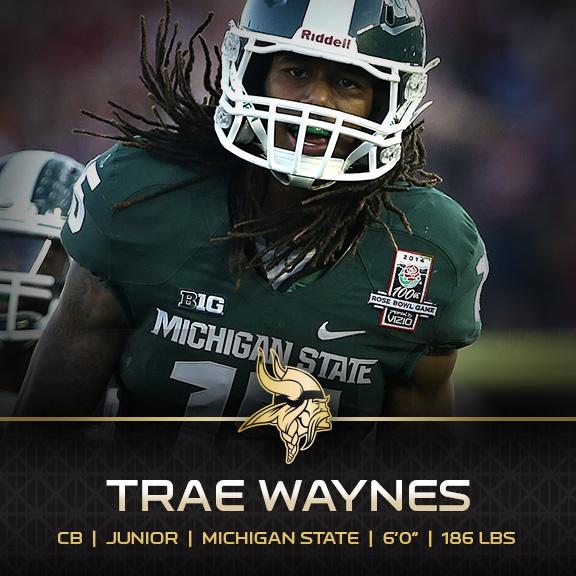 Well, few saw this coming … that Minnesota would actually use the #11 pick rather than trading down. Pretty much everyone read “Trader” Rick Spielman’s last pre-draft press conference as a clear attempt to get any kind of trade offer for the #11 slot, but perhaps no other team was all that interested in moving up.
Well, few saw this coming … that Minnesota would actually use the #11 pick rather than trading down. Pretty much everyone read “Trader” Rick Spielman’s last pre-draft press conference as a clear attempt to get any kind of trade offer for the #11 slot, but perhaps no other team was all that interested in moving up.
With their original pick, the Vikings selected Michigan State cornerback Trae Waynes. This is so boring: 90% of the mock drafts had this as the Vikings’ selection. Mr. Spielman, you’ve let us all down … where’s the drama? Where’s the suspense? Where’s the Earth-shattering Kaboom? How dare you do what everyone thought you’d do?

Initially (never having watched any of his college games), I was enthusiastic about Waynes, but as the pre-draft process wore on, I started to think he wasn’t the best scheme fit (and Arif Hasan’s analysis added to the niggling doubts). When Rick Spielman came out to talk to the media about the team’s pick, he said there had been some offers to trade, but that they didn’t feel the trade value was worth it, as they had Waynes high on their board. Unless this is smoke-blowing, I tend to believe that coach Zimmer feels that Trae Waynes is the best choice for the Vikings’ secondary.
Here’s Arif’s immediate reaction to the pick at Bleacher Report:
Known for only giving up two touchdowns in the past two years, Waynes’ ability to protect against vertical threats is unparalleled in college. He should provide the Vikings with some protection against the deadly passing attacks of the NFC North, which features deep threats and quarterbacks who like to exploit them.
With Kevin White (Miami) in the division, it increases the importance of a player who can keep up with his speed and provide some protection over the top.
There are a number of concerns about Waynes going in, some of which match the issues that Xavier Rhodes had coming out of the draft, including a predilection for grabby play and issues with short-area quickness.
Known for his high character, Waynes puts in time in the film room and can read receivers well.
On the flip side of that is a limited ability to read offensive concepts, and he struggles with route combinations. For the most part, the quarters defense at Michigan State made it less important to do so, although that unique defense also raises questions about his capacity to cover interior routes.



